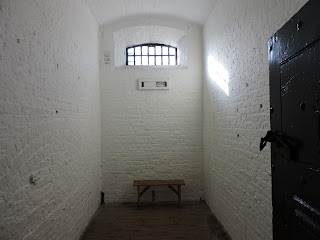 This is a post which Elizabeth and Meghann wrote for our academic blog about our trip in the footprints of the 1916 Easter Rising Rebels. This blog contains the adventures of Brad, Meghann, Elizabeth, and Eva.
This is a post which Elizabeth and Meghann wrote for our academic blog about our trip in the footprints of the 1916 Easter Rising Rebels. This blog contains the adventures of Brad, Meghann, Elizabeth, and Eva. ~~~~~~~~~~~~~~~~~~~~~~~~~~~~~~~~~~~~~~~~~~~~~~~~~~~~~~~~~~~~~~~~~~~~~~~~~~
Kilmainham Jail has been around since the 1700's and has held countless famous political prisoners, but it is most famous for being the place the 1916 Rising rebels spent their last days before they were shot.
 |
| Joesph and Grace Plunkett |
Some of the cells were opened. This is what a cell in the new part of Kilmainham Jail looks like.
Then we saw what the old part of the jail looked like. It was far lass nice and more typical.
 |
| The inside of a cell in the old jail. |
Across from the place where James Connolly was shot, is a cross that marks the place where the 13 other men stood before the firing squad and were killed one by one.
At the time of the Rising, it was probably the most unpopular rising in Irish History. When these rebels were taken away, even the locals were scoffing and spitting on them. This was because the rising took place during World War one when thousands of Irish men were overseas dying.
But the British made a fatal mistake by shooting these 14 rebels. In doing so, they became martyrs. In the course of two months, the support of the Irish had swung behind the Rising, and they were stirred up against the British, and in the following years, Ireland finally shook off the control of England.
The flag of the Irish Republic now stands in the courtyard of Kilmainham -- the result of what these men died for.
We then hiked to Arbour Hill where the Rebels are buried.
The mass grave where they are buried.
The Irish Republic proclamation is engraved on the wall. On the left in Gaelic and on the right in English.
Glasnevin by Meghann
Glasnevin was founded in 1850 by Oliver Cromwell. The cemetery is 124 acres and over 1.5 million people are buried here. Many important historical figures are buried here including Daniel O’Connell, Michael Collins, and Thomas Addis Emmet MD. We recently had a project where we read a biography of famous people in Irish history. My biography was Daniel O’Connell, it was at Glasnevin’s where I was able to meet him and his children. His grave is one of the easiest to find among the cemetery. Mostly because it is a 51 meter high round tower. He was originally buried in O’Connell square, but his body was moved when the tower was finished in 1865.
It wasn’t only important figures who were buried here, others who joined in the rebellion are as well. Like a woman named Margaret Skinidder, a primary school teacher by day and a sniper for the rebels during her free time. The people of Ireland are also buried here and are still being buried here. There are several mass graves among the traditional burials. Buried with Nicolas Parnell are 11,538 citizens of Ireland who fought and died for the republic. We were unable to explore the entire Grave site, but we were able to see some very significant tombs. It was truly awe-inspiring.



















No comments:
Post a Comment